- 1 Introduction
- 2 Crop management plans for weed control
- 2.1 Principles for the use of mechanical weed control technology
- 2.1.1 Harrowing and hoeing begin before sowing
- 2.1.2 Do not underestimate the time required
- 2.1.3 Principles for the use of tine harrows
- 2.1.4 Principles for the use of coulter hoes
- 2.1.5 Pseudo seedbed/pseudo tillage
- 2.2 Winter rape
- 2.3 Maize
- 2.4 Sugar beets
- 2.5 Potatoes
- Authors
1 Introduction
Mechanical weed control is a central element of successful crop growing in organic farming. And interest in mechanical weed control as an additional element of crop protection is increasing in conventional farming due to the increasing resistance of weeds to chemical active substances and because of the decline in the number of active substances that can be used.
Getting to grips with the weeds in good time during the cotyledon stage is crucial to the effectiveness of mechanical weed control. Depending on location, the optimum implementation period is severely limited due to weather and soil conditions. A farm-specific concept that is appropriate to the location therefore has to be developed. In this Expert Knowledge Series pamphlet ‘Mechanical weed control – practical concepts for cereals’, consultants show which aspects need to be focused on when developing an operational strategy, and experienced farmers provide an insight into the concepts used in their locations.
2 Crop management plans for weed control
2.1 Principles for the use of mechanical weed control technology
The success of mechanical weed control methods is influenced by numerous factors such as the weather, the soil type, the soil condition and the species of weeds as well as their development stage. The machine settings, the working speed, the scheduling of the measures and ultimately also the farmers themselves are equally crucial. Despite modern, functioning technology, it can occur that the desired control success is not always forthcoming and the anticipated work rate is not achieved.
2.1.1 Harrowing and hoeing begin before sowing
So that the harrowing and hoeing technology can operate precisely and without disturbances, the following points must be observed even prior to and during sowing:
- Attention must be paid to careful primary cultivation, seedbed preparation and sowing. A level, well re-compacted seedbed without deep tractor tracks and consistent seed depth placement are extremely important for the precise use of mechanical weed control methods.
- ‘Light’ tractors with wide tyres or two tyres as well as tyre pressure control systems should be used in soil tillage wherever possible. This enables deep ruts and harmful soil compaction to be reduced.
- Rolling after sowing may prove sensible if the seedbed is too rough. This enables the establishment of better working conditions for the subsequent mechanical methods. Rolling must be weighed up in locations that are at risk from erosion.
- In the case of primary cultivation without the use of a plough and mulching, excessively coarse and long plant residues can impede the work of harrows and coulter hoes. Plant residues can build up or the hoeing tools can become clogged. The use of mulchers, cutter rollers or cutting tools to shred the organic substance improves the performance of the mechanical control implements.
- It is crucial to coordinate the sowing and hoeing technology. To do this, the number of sowing and hoeing units must match. To ensure disturbance-free operation of the hoeing tools, the sowing units must be set to the precise row spacing and the track markers must be adjusted correctly for precise row closure. This is where the most frequent errors occur by far in practice.
- Sowing with parallel guide systems is extremely advantageous for the subsequent work with a coulter hoe. Sowing in absolutely straight rows can extensively relieve the driver, particularly in the case of coulter hoes without a steering system.
- At the edge of fields, the first row of seeds must be planted a sufficient distance away from the edge so that the outer coulter hoe unit can operate undisturbed.
2.1.2 Do not underestimate the time required
A high quality of work with a high work rate at the same time is important to many farmers. However, this can quickly result in conflicting aims in mechanical weed control methods. The basic principle is that quality of work takes precedence over the work rate.
- The time required to correctly set the implements and to regularly check the success of control and crop losses during the work is regularly underestimated. The conditions can vary extensively from field to field. Constant checks are therefore required during harrowing and hoeing and the machine settings have to be adjusted time and again. There are no generally applicable implement settings or working speed.
- When using tine harrows and coulter hoes in sensitive crops or during early stages of development, a reduced working speed of around 3 and 5 km/h often has to be implemented to prevent crop damage. This reduces the work rate.
- Only limited time slots might be available due to weather conditions. Efficient technology that is adapted to the area to be worked must therefore be provided. Using hoes or harrows early in the morning in dew-covered crops, for instance, is only recommended to a limited extent or not at all, and may only be possible as of the late afternoon at the earliest.
- Phases of unsettled weather with rainfall usually prohibit the use of mechanical methods. As a result of this, scheduled or due work cannot be completed on time, leading to the risk that the weeds develop too extensively and can then no longer be controlled in a satisfactory manner.
- Planning and scheduling the required measures necessitate continuously monitoring the weather and checking the fields as regards soil condition and weed and crop development.
- Settings for and the implementation of mechanical methods should only be undertaken by suitable, qualified staff who have good knowledge of crop production and also come equipped with calmness, experience, motivation and the ‘finesse’ needed to handle this technology.
2.1.3 Principles for the use of tine harrows
- It must essentially be remembered that the controlling effect of tine harrows is based largely on uprooting and covering the still small weeds during the filament and cotyledon stages. High efficiencies of over 80 percent per pass can be achieved with the harrows in these stages. The removing and covering effect quickly decreases as the size of the weeds increases.
- Regular field inspections and precise monitoring of weather forecasts are needed to schedule the use of harrows specifically in the filament to cotyledon stages. Black grass, wind bent grass, common lamb’s quarter or knotweed species, for instance, can only be controlled most effectively up to the cotyledon stage.
- A sheet of glass or Perspex placed on the ground can help when inspecting the field. The weeds emerge earlier under the sheet and therefore make it easier to schedule harrowing measures, particularly for blind harrowing prior to emergence.
- It must also be taken into account that each soil movement encourages further weed seeds to germinate. Harrowing should therefore be carried out as shallow as possible. The following harrowing operations must be aimed at re-germinating weeds.
- The covering effect of the harrow declines significantly with larger weed plants approximately as of the second foliage leaf pair. Whilst it can be increased by increasing the working speed, this comes at the expense of crop compatibility. The removal of weed plants in advanced stages declines considerably due to their more extensive roots.
- The desired intensity of the harrow is varied via the working speed, the working depth and, depending on make, by means of either the spring pre-load or the setting angle of the tines. The harrow settings and working speed must be regularly checked on the field and adapted if necessary.
- However, crop losses of between 1 and 3 percent per harrow pass are often unavoidable depending on the crop type and size. In the event of significantly higher losses, the settings and working speed must be corrected. The possible harrowing losses should be taken into consideration during sowing by increasing the seeding rate by approximately 10 – 15 percent.
- There are no generally valid specifications for the settings or driving speed. Numerous aspects such as the make of harrow, soil type, soil condition, weed size, crop type and size, for instance, are determining factors.
- Driving very slowly in speed ranges from approximately 2 to 5 km/h is necessary during early, sensitive crop stages. Working speeds of around 5 to 10 km/h are possible in larger crop stages or when blind harrowing crops that are sown deeper.
- In order to minimise crop losses due to breaking off, care measures should only be undertaken as of approximately the late morning, when the cell pressure in the plants decreases and the plants are more elastic.
- Wherever possible, the work should also be carried out in sunny and windy weather in order to ensure that the weeds are dried quickly.
- The soil surface should be dry and free-flowing at the time of harrowing. Harrowing should be forgone in the case of excessively moist soil conditions, unsettled weather and low evaporation. Harrowing must only be undertaken when navigability is ensured, the soil is free-flowing and the weather is frost-free, dry and sunny.
- Newcomers, above all, often use harrows too often because they are concerned about excessive residual weed development. Depending on the type of crop and the development stage, excessive harrowing intensities can lead to growth impairments that impact on yields. It is also ecologically and economically nonsensical to harrow the very last dead nettle or the very last pansy from the crop. Consideration must also be given to the protection of ground-nesting birds and small game.
2.1.4 Principles for the use of coulter hoes
- Hoeing should generally be carried out as shallow as possible. However, the objective of cutting the weeds off over the entire surface must always be ensured. Excessively deep cultivation must be avoided, as seeds are increasingly encouraged to germinate on the one hand and water loss is increased on the other hand. The erosion risk factor must also be taken into account.
- A variety of different hoeing tools such as double-disc coulters, flat hoeing blades or angled blades are available for the area between the crop rows. They must be coordinated to the soil types that occur in the region. If several coulters are used between the rows, sufficient coulter overlap must be ensured to guarantee full-area hoeing.
- The objective is to guide coulters as close to the crop as possible without covering or damaging it. Protective discs or protective plates on the coulter hoe are therefore required in small crop stages. This particularly applies in the case of camera-guided coulter hoes. Higher working speeds can be achieved with these, as a result of which the risk of covering increases.
- As for harrowing, the time selected for hoeing should be the late morning or the early afternoon. Sunny weather ensures that the weeds are dried quickly.
- When using coulter hoes with camera control, it must be ensured that the tractor’s lower link side struts are locked to avoid undesired lateral movements. The lifting struts must be set so that the hoe is guided parallel to the surface of the soil and can plunge evenly into the soil. The upper links can be used to adjust the hoe horizontally or set it gently against the tip of the hoeing shares in more difficult soil conditions.
- Numerous tools are also available for controlling weeds within the crop rows. Depending on soil type, crop and development stage, these include finger hoes, roller harrows, torsion spring tines, trailing harrows and flat ridgers as well as various other ridging bodies.
2.1.5 Pseudo seedbed/pseudo tillage
Pseudo tillage’ can prove suitable if the pressure caused by weeds is expected to be high. Primary cultivation, followed directly by seedbed preparation (pseudo tillage), is carried out three to four weeks before the crop is scheduled to be sown. The subsequently emerging waves of weeds can then be controlled with harrows or other soil tillage implements that operate at shallow levels before the actual sowing. The tillage encourages other weed seeds to germinate. Depending on weed pressure, these are controlled either with a further pass or by tillage during crop sowing. The selected tillage depth should be as shallow as possible in order to not impair the moisture conditions for seed germination. Prior to tillage, however, the depth from which the weeds are germinating must be checked in order to control as many of the seedlings as possible. Knotweed species, in particular, can germinate from deeper layers of soil. Deeper tillage may then possibly be required after all. Flame weeding technology can also be used as an alternative, particularly for weeds that emerge from deeper layers of soil. This would offer the advantage that further weed seeds are not encouraged to germinate by excessively deep soil tillage and that the soil does not dry out too much. This method is comparatively expensive, however.
The necessity of a pseudo seedbed must be weighed up, because disadvantages such as an increased risk of erosion due to wind and water as well as the drying out of the seedbed have to be taken into consideration.
2.2 Winter rape
Comparatively few findings and test results concerning mechanical weed control are available for winter rape. Initial trials by the Landwirtschaftskammer Niedersachsen indicate that the use of harrows is difficult. Blind harrowing prior to emergence was not possible due to shallow seed placement and rapid emergence. In the cotyledon stage, the harrows caused high rape losses. Tolerance improved as of the first foliage leaf pair. However, high rape losses still occurred even then in the case of unfavourable soil conditions (rough seedbed). Further trials are necessary for a reliable statement. Winter rape is obviously more suitable as a root crop. Own tests revealed low rape losses and comparatively good control success. Finger hoes and flat ridgers were additionally used to control weeds within the plant rows in the two-year trials. The finger hoes achieved better control success than the ridgers. Further trials are planned.
In practice, winter rape is managed primarily as a root crop. Row spacings of between 25 cm and 50 cm are possible. However, the 45 cm row spacing is likely to predominate, since this enables beet hoeing technology to be used. Since rape branches well and is therefore able to close the rows later on, such wider row spacings can be implemented without problems. Companion sowing or undersowing are a good approach for indirect weed control by means of competition and shading. Investigations have already been carried out with legumes or other species that die off in frost and have produced some very interesting results. Dense seeding of rape is also practiced in organic farming. To do this, the rape is sown at a seeding rate that is approximately 30 percent higher than row seeding. No mechanical weed control is carried out. Instead, the rape plants’ ability to suppress weeds is exploited.
2.3 Maize
As maize is very weak in the face of competition from weeds during early growth, mechanical control has a significant influence of the success of cultivation. Additional preventative weed control measures must also be taken into consideration.
Give consideration to preventative measures
- The objective is to achieve rapid emergence and early growth after sowing so that the maize has and maintains a growth advantage over the weeds.
- For rapid emergence, it is crucial that the soil has reached a temperature of at least 10 to 12 °C at a depth of 5 to 6 cm by the time of sowing. Sowing should additionally be carried out during a prolonged warm weather phase. Later sowing dates should therefore be scheduled and maize varieties that mature early on should be selected accordingly.
- Preference is to be given to quick-growing maize varieties that are able to tolerate low temperatures. Species with a planophile leaf arrangement lead to earlier ground coverage and are therefore able to suppress the weeds better. The state organic grain and silage maize trials conducted by the Landwirtschaftskammer Niedersachsen also demonstrate noticeable differences between varieties.
- A pseudo seedbed (see section 2.1.5) can prove suitable if the pressure caused by weeds is expected to be high.

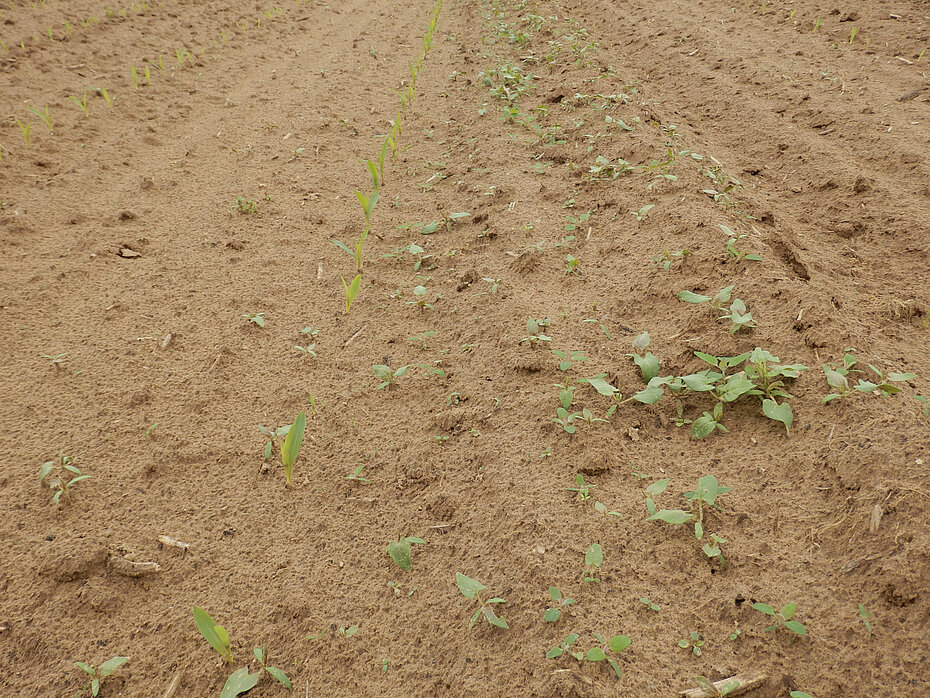
(source: Markus Mücke, Landwirtschaftskammer Niedersachsen)
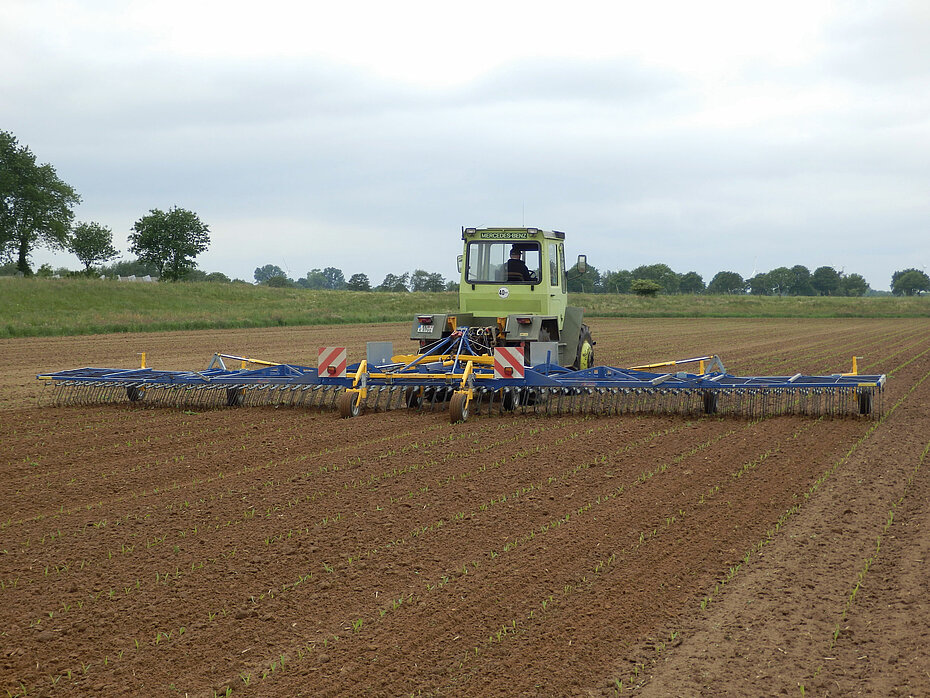
Use tine harrows early on
Due to its wide row spacings, maize is essentially a root crop. Effective mechanical weed control cannot be ensured with coulter hoes alone, however. As a flanking measure, tine harrows extensively support successful control, as they can be used to significantly reduce weed infestation early on after sowing and emergence.
Blind harrowing prior to emergence
Blind harrowing prior to emergence may be necessary just a few days after sowing. More intensive harrowing prior to emergence is also easily possible, as the maize is planted at a depth of approximately 4 to 6 cm. Soil is moved anew with each pass of the harrow, as a result of which further weed seeds are encouraged to germinate, which is why further harrowing operations must be aimed at newly germinating weeds.
Post-emergence harrowing
Following emergence, harrows remain central control implements alongside coulter or roller hoes. Specific use in the aforementioned early weed stages also applies in this case. However, the different sensitivities during the early development stages of the maize plants must also be taken into account during harrowing.
Maize is very sensitive to harrowing when the seedling is just about to break through the surface of the soil or is already emerging. Harrowing should therefore be forgone. The maize’s harrowing tolerance improves as of the 1st foliage leaf (BBCH 11). During this phase, work must be carried out at a reduced speed (approx. 2 – 5 km/h) and possibly a lower harrow tine pressure or a reduced tine setting angle. Particularly during the early maize development stages, harrowing should only ever be carried out as of the late morning when the cell pressure in the plants decreases and the plants are more elastic and therefore do not break off so easily.
When using harrows following emergence, it must be ensured that the maize plants are not covered or skewed due to an excessively high working speed. They only straighten up very slowly and lag behind in their continued development.
Wide choice of hoeing tools
Coulter hoes can also be used as the maize rows become visible. When used this early, protective plates or discs are recommended to prevent the small maize plants from being covered. Coulter, star or roller hoes can be used as working tools. If weed development has already progressed, cutting hoeing tools often achieve more reliable control than rolling tools, also depending on the soil type. However, the crucial question of how weed growth within the maize rows can be controlled remains. Various additional implements that can be combined with the coulter hoes are available for this. They can significantly improve control success.
Finger hoes operate within the maize rows
Finger hoes can be used very well in maize as of around the trifoliate stage (BBCH 13). They are additionally mounted on the coulter hoes. Driven over the soil, a rotating metal disc equipped with flexible rubber fingers works into the plant row from both sides. They can be used on virtually all soils. However, the adjustment effort is comparatively high. It has to be done very precisely to avoid crop damage. Stones can also become trapped in the finger elements and lead to damage in the maize rows.
Torsion spring tines
Torsion spring tines are another additional tool for the coulter hoes. Sprung tines whose ends are slightly angled work on both sides of the crop row. Both tines operate by vibrating at a flat setting angle. The inclination and the distance from the crop are adjustable. The weeds are covered or also exposed so that they can dry out. Good control success is to be anticipated, particularly on looser, more sandy soils.
Roller harrows
On roller harrows, steel tines are cast into a plastic disc in a star formation. The star-shaped tools are set at an angle of 30 ° diagonal to the direction of travel. The setting angle can also be adjusted. During operation, they are caused to rotate and comb through the soil over the entire surface. The weeds are torn out, but are primarily covered.
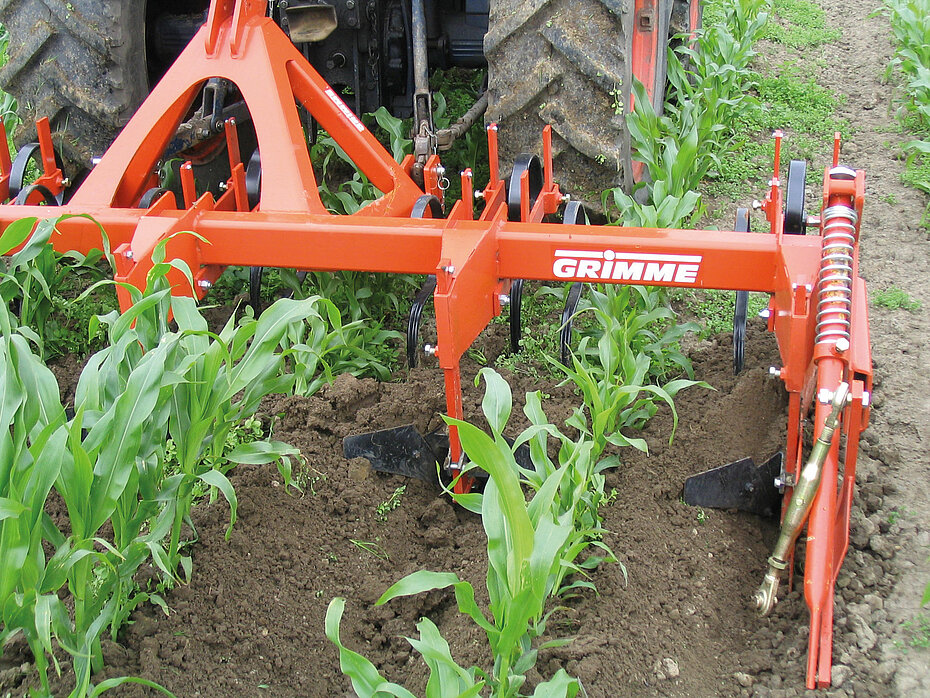
(source: Markus Mücke, Landwirtschaftskammer Niedersachsen)
High efficiencies through earthing up
Tools with a ridging or covering effect are very suitable for use in maize. They are comparatively inexpensive and can achieve a good covering effect with weeds. It must be noted that shallow ridging tools have to be used particularly precisely during early maize growth. If the young maize plants are pushed to the side or even covered by the piling-up soil, they only straighten up very slowly and lag significantly behind in terms of their growth. Special shallow ridging shares, ridging discs or ridging shares that are mounted on the hoes’ hoeing shares can be used, for instance.
Roller hoes have also proved suitable in maize cultivation. Depending on the tool setting, they can ridge both away from and towards the row of maize.
Using potato ridging technology
From a growth height of around 30 to 40 cm to just prior to row closure, inexpensive ridging technology from potato growing can also be used as a concluding measure. With a row spacing of 75 cm, this technology can also be used well in maize. Trials conducted by the Landwirtschaftskammer Niedersachsen have shown that considerable control success can be achieved and that the maize also tolerates the ridging well. Ridging additionally leads to better soil heating, which in turn improves nutrient mobilisation and therefore ultimately maize growth. If corresponding spreading technology is available, slurry or digestate can be spread in the growing crop prior to ridging and is then worked in with the ridger.
Thermal weed control in maize
In locations with very high weed infestation, thermal control can be implemented following the emergence of the maize. The Organic Farming department of Landwirtschaftskammer Niedersachsen has tested this method in three-year trials.
The trials showed that flame weeding with a flame weeder that operates over the entire surface is possible without problems in the maize plants’ 1st foliage leaf stage (BBCH 11). Only the leaf that has formed at the side dies off due to the heat. The shoot of the young maize plant remains vital. The maize plants regenerate comparatively quickly after flame weeding by forming new leaves. Plant losses do not occur in this stage, and no retarded growth was ascertained. As the weeds are also usually small during this early maize stage, very high control success of 80 to 90 percent has been achieved.
Later flame weeding dates were also investigated. It was shown here that the maize can still be flame weeded over the entire surface in the 2nd foliage leaf stage (BBCH 12). Only very slight maize losses occurred. However, the regeneration of new leaves took longer and the maize needed more time to make up for the growth gap again compared to the control. Control success was around 80 percent. The advantage of flame weeding is that neither harrowing nor hoeing are carried out until it is undertaken, meaning that no further weed seeds are encouraged to germinate beforehand or due to the actual flame weeding. In the trials, one to two subsequent passes with coulter hoes were usually sufficient to control late weed development.
This method becomes more interesting if row flame weeding technology is available. The space between the maize rows could then be hoed mechanically and only the maize rows themselves flame weeded. This would significantly reduce gas costs and control success within the maize rows would be ensured.
2.4 Sugar beets
Only mechanical methods and preventative measures have to be applied in organic sugar beet growing. At present, weed control can only be undertaken satisfactorily in organic sugar beet growing with the additional use of a manual hoe. In addition to the high costs, which significantly impact on the growers’ profitability, it is above all the availability of seasonal workers that poses a major problem. High control success therefore has to be achieved through preventative and mechanical measures, a demanding goal.
During their early growth, sugar beets are comparatively weak in the face of competition. They only achieve a high level of shading and therefore high weed suppression capacity when the rows close. The basic principle for mechanical methods is to always mechanically control the emerging weeds in the early stages, from the cotyledon stage to around the 1st foliage leaf pair at the latest, so that the beets always have a growth advantage.
Pseudo seedbed prior to sowing
A pseudo seedbed is suitable for controlling weeds prior to actual sowing. This method has already been described in section 2.1.5.
Thermal control prior to sugar beet emergence
The thermal control of weeds or potato halum using gas flame weeding technology is one of the standard measures used in organic field vegetable and potato growing. The use of flame weeding technology can also be used in beet growing prior to the emergence of the beets. The advantage of thermal control is that no further weed seeds are encouraged to germinate. Particularly in humic, more sandy locations in which the soil heats up faster and high weed pressure occurs early on, flame weeding prior to the emergence of the beets can lead to high control success and is to be given preference over blind harrowing. Using Farmflex rollers as coverers is recommended when sowing beets, as they leave closed sowing grooves behind. Conversely, finger pressure rollers leave behind a relatively open sowing groove, as a result of which the beet pills, which have already begun to sprout, can be significantly damaged by flame weeding.
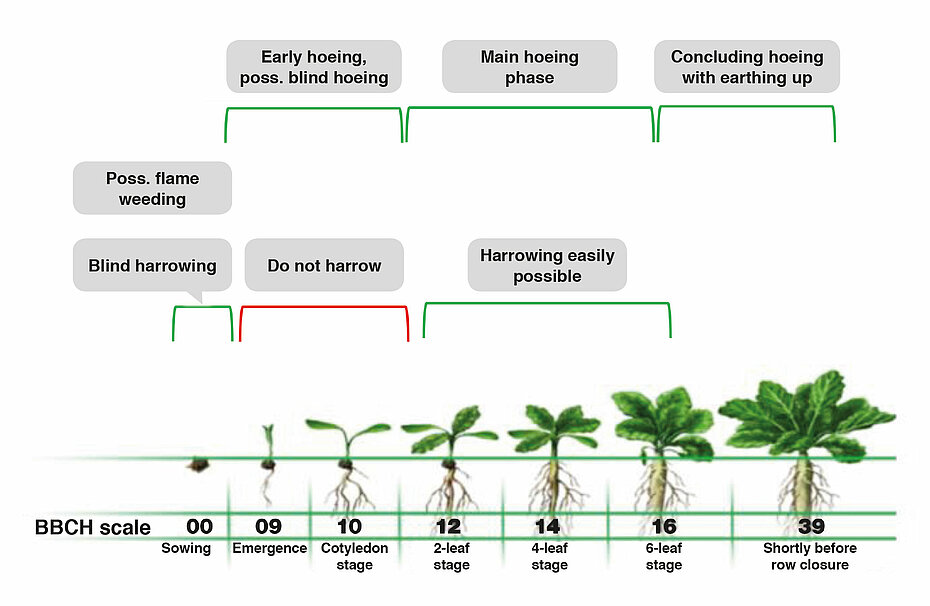
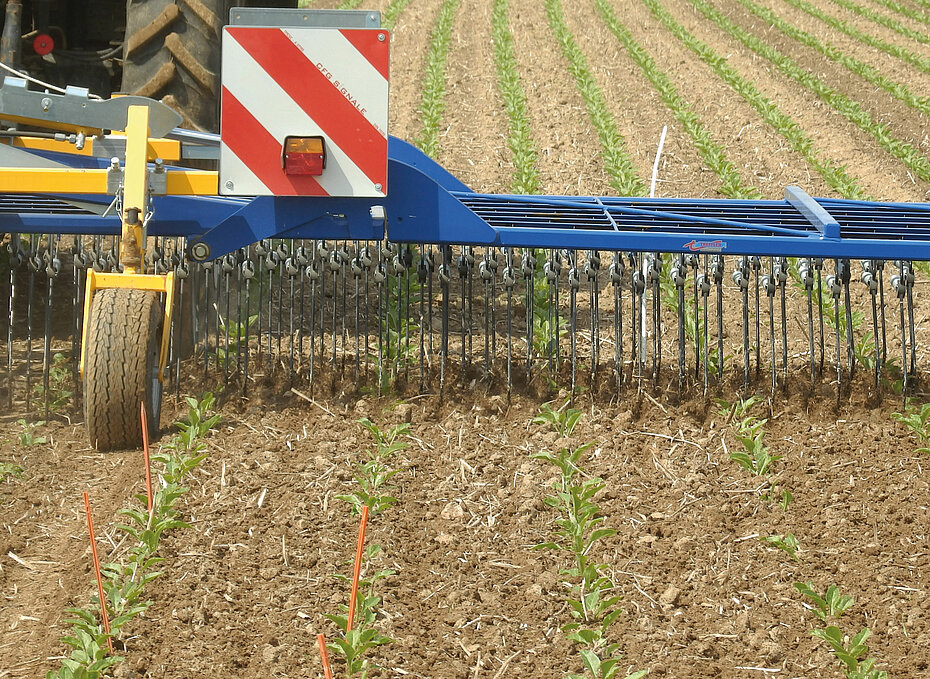
(source: Markus Mücke, Landwirtschaftskammer Niedersachsen)
Sugar beets can be harrowed
Sugar beets can be harrowed, as five-year trials conducted by the Landwirtschaftskammer Niedersachsen have shown. Blind harrowing prior to emergence is possible. However, this necessitates precise depth control, a flat, well re-compacted seedbed without deep ruts and consistent and deeper planting of the beet pills at a depth of approximately 3 to 3.5 cm. If these conditions do not exist or the sprout has already clearly emerged from the beet pill, beet losses can significantly exceed 20 percent.
The emergence phase and the cotyledon stage of the beets (BBCH 10-11) are critical periods for harrowing. High average losses of 20 percent per harrowing pass were recorded here. Harrowing is therefore risky. The coverers used on the sowing units also influence the harrowing result. Depending on soil type, the finger pressure rollers on the sowing implements leave behind a slightly wedge-shaped, open sowing groove. At the same time, the grooves pose the risk of the small beets being injured during harrowing and, above all, that they are covered too extensively. Using Farmflex rollers as coverers is more advantageous, as these reliably cover the beet pills with soil and leave behind a level soil surface depending on their settings. Alternatively, the finger pressure rollers’ sowing grooves can also be levelled using a field roller.
The beets’ harrowing tolerance improves significantly as of their first foliage leaf pair (BBCH 12). The beets are already well rooted and anchored in the soil. In the trials, the average losses over multiple years amounted to four percent per pass. In the subsequent development stage (BBCH 14; 2nd foliage leaf pair), they were an average of one percent. Harrowing transversely to the seeding direction was also investigated. The beet loss results in this case were identical to those for harrowing in the seeding direction.
An ongoing trial that is being financially backed by the state of Niedersachsen is examining the success of weed control. Two-year results are available so far. With one harrowing pass in the seeding direction, the weeds were reduced by an average of 20 (in BBCH 12) or 40 percent (in BBCH 14) within the beet rows – i.e. the area not tilled when using the coulter hoes – per harrowing pass. The effect is improved if harrowing is carried out transversely to the seeding direction. In this case, the reduction in weeds per harrowing pass was between 50 and 60 percent.
Harrows are effective implements in the mechanical weed control strategy in sugar beets. Harrowing diagonally or transversely to the seeding direction is particularly suitable after using coulter hoes. This allows the weeds from the narrow unhoed strip within the beet rows to be easily pulled into the space between the beet rows and also covered. Working with wide tractor tyres and the minimum tyre inflation pressure is recommended to protect the crop when harrowing transversely. Practical tests conducted by the Landwirtschaftskammer Niedersachsen have also shown that working with wide tractor tyres and a minimum tyre inflation pressure of around 0.5 bar is possible without problems during transverse harrowing. If possible, the air pressure in the harrow’s support wheels must also be reduced.
The harrow settings and the working speed must be adapted to the specific location. No standard recommendations are possible for this. Harrowing technology with indirect suspension was used in the trials; this is comparatively gentle on the plants, particularly in sensitive crops or in early crop stages.
For special purposes: rotary star hoes as crust breakers
Depending on the soil type, heavy rainfall can lead to significant capping with subsequent crusting of the soil surface. This results in reduced soil gas exchange, which can significantly impair the sugar beets’ growth. As trials conducted by the Landwirtschaftskammer Niedersachsen have shown, the use of rotary star hoes is suitable for eliminating capping or crusting.
In the trials, relatively low (five percent) and no beet losses were determined on average over the two years in the first foliage leaf pair (BBCH 12) development stage and the second foliage leaf pair (BBCH 14) respectively. Losses of 15 percent were only ascertained in the cotyledon stage.
Rotary star hoes are machines for special purposes. They can be a sensible addition to tine harrows in order to optimise their effect or to improve the growth conditions of capped crops by loosening and aerating the soil. They are particularly suitable for use across farms.
Use of coulter hoes
The following essentially applies when using coulter hoes: hoe as deep as necessary and as shallow as possible. The objective is to cut off all weeds over the entire surface. Excessively deep cultivation must be avoided, as this increasingly encourages weed seeds to germinate.
A variety of different hoeing tools such as double-disc coulters, flat hoeing blades or angled blades, for instance, are available for the space between rows. They must be coordinated to the soil types that occur in the region.
The smaller the beet, the closer hoeing should be carried out up to the plant. The objective is to guide the coulters as close to the crop as possible without covering it. Angled blade hoeing shares have proved more suitable than double-disc coulters in this early beet stage. Protective discs or protective plates on the coulter hoe are therefore sensible in small beet stages. This particularly applies in the case of camera-guided coulter hoes. They can usually be used to achieve higher working speeds. This also increases the amount of earth thrown out to the sides by the hoeing blades, resulting in a significantly higher risk of covering.
Initial use of the coulter hoes in beets should not be delayed for too long in order to control the weeds as early as possible in the small stage. Early hoeing in the beets’ cotyledon stage would be ideal. Depending on light conditions and due to inconsistent emergence, camera-guided hoeing systems do not yet operate with sufficient reliability in the early beet cotyledon stage. Plant row detection only improves as of the beets’ first foliage leaf pair (BBCH 12).
When sowing with RTK, the stored data could be used for the subsequent coulter hoes for early hoeing (blind hoeing). Subsequent hoeing operations must be carried out depending on weed pressure and must be undertaken in combination with tine harrows if necessary.
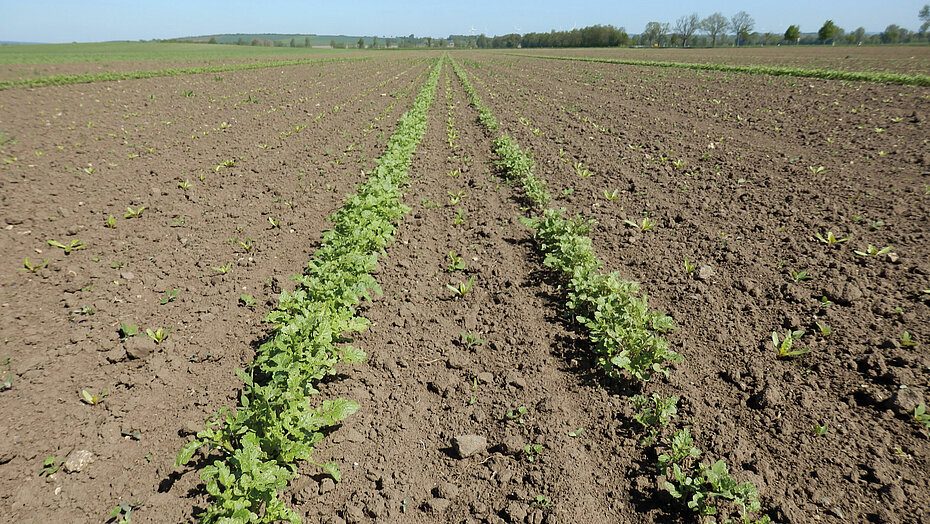
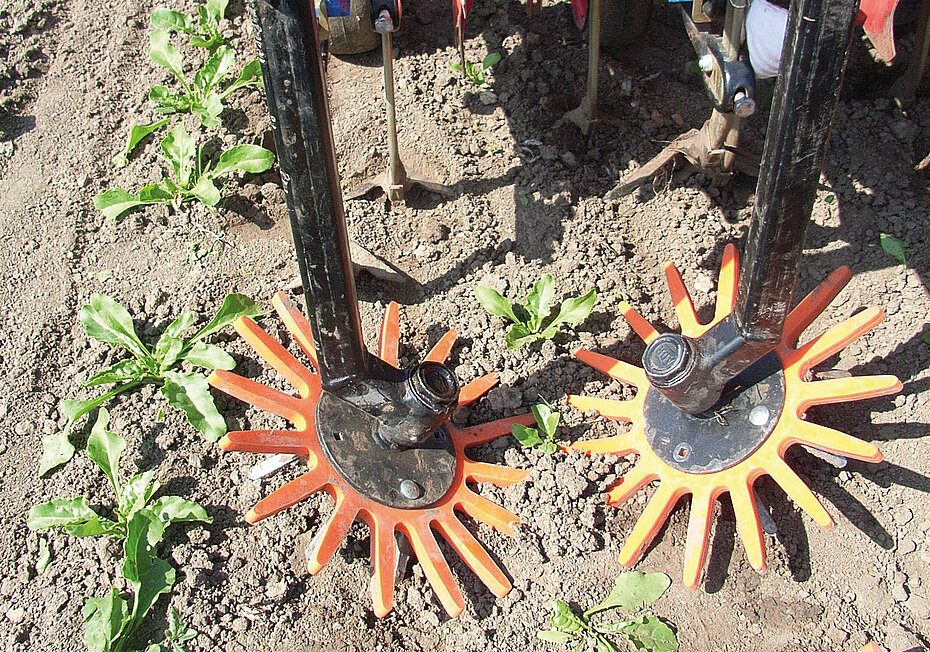
Practical solution – marker seed
A contractor and an organic farmer from the administrative district of Wolfenbüttel, Niedersachsen have come up with a solution using a marker seed to enable hoeing with camera-guided hoeing technology even in very early beet stages. While sowing the beets,
a granule spreader mounted on the sowing implement is used to sow a marker row of mustard. The mustard emerges far faster than the beets and can therefore be detected relatively reliably by the camera systems while the beets are still in the cotyledon stage. For the first early hoeing pass, the camera on the coulter hoes is trained on the row of mustard. The strip of mustard is then also eliminated during the first hoeing pass, as the beet rows are reliably detected by the camera technology during the second hoeing pass.
Weed control within crop rows
A variety of different hoeing tools are available for the space between rows. Flat hoeing blades or angled blades, for instance, are very suitable in early beet stages. Protective discs or protective plates are also sensible. Particular focus must be placed on weed control within the beet rows. Besides the previously explained harrowing diagonally or transversely to the seeding direction, an entire range of additional mechanical tools is available for the coulter hoes. Finger hoes can be used well in sugar beets. Further possible tools include torsion spring tines for lighter soils, roller harrows or flat ridgers. Ridging tools are particularly suitable for the final pass prior to row closure, as they achieve an outstanding covering effect.
Finger hoes, for instance, are most suitable for sugar beets. Driven over the soil, a rotating metal disc equipped with flexible rubber fingers works into the plant row from both sides. The distance between the two finger discs is adjustable. Various rubber finger diameters and hardnesses are available. The finger hoes can be used on virtually all soils. Initial adjustment is somewhat time-consuming. They can be used in beets as of the first foliage leaf pair (BBCH 12) at the earliest. Significant beet losses can occur if they are adjusted incorrectly. However, finger hoes can be used reliably as of the second foliage leaf pair (BBCH 14).
Good control effects within the crop row can also be achieved with ridging tools. In sugar beets, these inexpensive tools can achieve outstanding control success as of around the 3rd to 4th foliage leaf pair (BBCH 16 to 18) and then up to the last possible moment prior to row closure. Various ridging plates or flat ridgers that are mounted on the hoeing tools are available.
2.5 Potatoes
Unlike in conventional potato growing, in which the finished ridges are often shaped during planting, the ridges are usually only built up over the course of the growth phase in organic farming. The basic principle involves repeated cultivation of the potato ridges by alternately harrowing and earthing up. The objective is to control the emerging waves of weeds at an early stage by exposing and covering them.
Various implements are available for cultivating the ridges. Besides tine harrows and chain-link harrows, various ridging implements such as share and disc ridgers as well as roller hoes with different ridge-forming plates can also be used. Rotary ridgers are preferably used on loamy soils.
Start with the first weeds
Weed control should be started after planting as soon as the first weeds are in the filament stage, i.e. just prior to emergence, or in the cotyledon stage. The control measures must then be regularly repeated with each newly emerging wave of weeds. Depending on the weather, the time span between the individual measures can be between five and 14 days. If the control measures are delayed for too long, the weeds increasingly develop leaf and root mass and can then no longer be controlled reliably.
Avoid injuries
Following the emergence of the potatoes, care must be taken during the control measures not to damage the lateral roots and stolons, and later on the developing potato nest. The tools must be set to operate at a shallow depth.
Excessive coverage of the potato leaves must be avoided on earthing up. However, differences between varieties must also be observed in this case. Varieties with leaves lying low down on the ridge are more sensitive than varieties with stems that are positioned steeper.
A staged ridge structure is usually easy to implement in lighter soils. In more loamy soils, the ridge is usually built up with a rotary ridger as the potatoes emerge. Covering the young plants in the rosette stage is not a problem. They usually grow out of the ridge again quickly. Further waves of weeds can then be controlled by harrowing and earthing up over the continued course of growth.
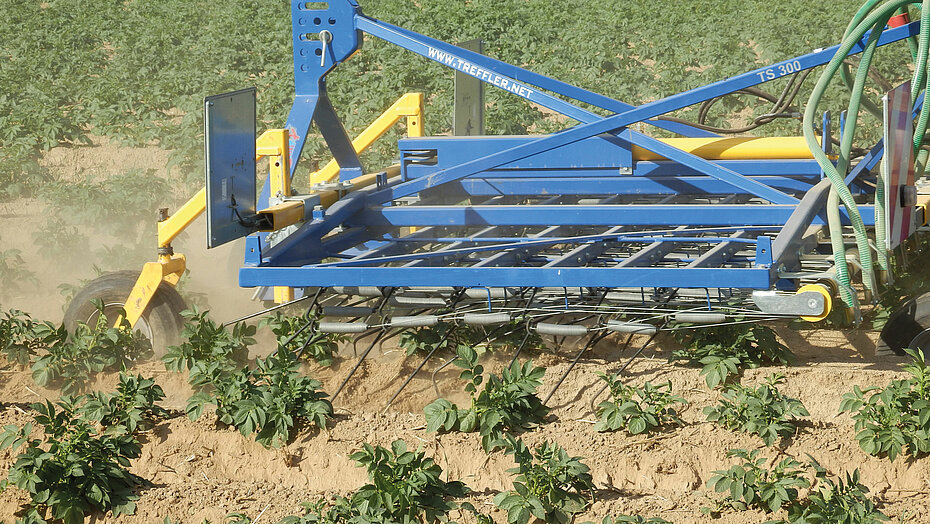
Use of tine harrows
Harrows or chain-link harrows can and should be integrated into the weed control strategy for potatoes. The first wave of weeds after planting can be controlled very well using tine harrows or chain-link harrows in the early filament stage. Implementation can be repeated if necessary. However, chain-link harrows should no longer be used after the potatoes’ rosette stage in order to avoid damage.
Tine harrows with direct suspension do not achieve ideal working results in ridge crops, as the tines harrow the ridge crest excessively and work inadequately in the ridge valley. However, their use is justifiable up to the emergence of the potatoes. Following emergence, the potato plants can also be damaged excessively by the directly sprung tines.
Give preference to harrows with indirect tine suspension
Conversely, tine harrows with indirect suspension can be used very well on potato ridges prior to emergence, but also following the emergence of the potatoes. Despite the different position of the tines, the pressure on the ridge crest and the ridge flanks is primarily the same. Uniform ground adaptation and weed control as well as operation that is gentle on the crops are achieved as a result of this.
The use of harrows leads to the fact that a small part of the ridge is removed again. This desired effect covers weeds in the ridge valley and exposes weeds on the ridge flanks and the crest so that they dry out.
In potato growing, weeds can be controlled well with a combination of mechanical implements. Only late weed development can lead to problems in crops that are dying off. Undersowing could prove to be a remedy to this problem. Another option is thermal control with flame weeding technology that operates independently of rows.
Thermal control as a further alternative
The thermal control of weeds or killing off potato halum using flame weeding technology is one of the standard measures used in organic field vegetable and potato growing.
The basic principle behind this method is to damage the plant cells, not to burn the plant. In thermal control, the proteins in the cells coagulate and the cell walls burst, causing the foliage or the plant to dry out and ultimately to die off. Control success can be easily checked by means of a finger test immediately after the pass. To do this, a leaf is crushed between the thumb and index finger. If control has proved successful, a dark green discolouration remains visible, in which the finger grooves are also recognisable in the case of larger leaves.
The efficiency of flame weeding is variable and is dependent on the size and species of the plants, the weather and the time of implementation.
Various manufacturers offer flame weeding technology that controls weeds over the entire working width or that only operates in the area of the crop rows – so-called row flame weeding technology. Working widths of 3 m or 6 m are primarily used in full-surface flame weeding technology. All manufacturers use gas as the energy source. High-volume gas tanks (with a capacities of approx. 600 litres) in the three-point linkage are available from various suppliers for transporting the gas. These can be either rented or purchased. The flame weeding technology operates either with burners with a naked flame or special infrared emitters are used. In the full-surface flame weeding implements, the combustion chambers are equipped with adjustable side panels. These are intended to offer protection against the influence of side winds so that the heat can be kept in the combustion chamber for a long time. The full-surface flame weeding technology has been continuously evolved. In modern implements, blowers ensure better and uniform heat distribution. This technology has enabled the gas consumption to be reduced by around 20 to 30 percent.
The full-surface flame weeding technology can be used to prematurely control the potato halum for subsequent objectives:
- Fostering uniform maturation and peel firmness
- Achievement of earlier harvesting in order to reduce the risk of wire worm and Rhizoctonia
- Late blight can be reduced in the ridge in the event of a severe infestation
- Control of the starch content and exertion of an influence on the size of the tubers
Combined use of haulm toppers and flame weeding technology is often preferred in practice. Flame weeding prevents the topped residual stem from sprouting again.
However, the flame weeding technology can also be used very well to control late weed development prior to harvesting. This can make harvesting considerably easier, but can also reduce the spread of weed seeds.
Correctly scheduling potato halum control using the thermal method, also in combination with mechanical topping, depends on numerous factors such as the variety, weather and late blight infestation, for instance.
Authors
- DLG Organic Farming Committee
- Markus Mücke, Consultant Organic Crop Production, Landwirtschaftskammer Niedersachsen
- Christian Kreikenbohm, Consultant Organic Crop Production, Landwirtschaftskammer Niedersachsen
Editorial office
- Dr. Achim Schaffner, Project Manager Organic Farming, DLG e.V.
Title image: Markus Mücke, Landwirtschaftskammer Niedersachsen

